Theoretical Research on Circular Economy and Sustainability Trade-Offs and Synergies
Abstract
1. Introduction
Research in the Era of Sustainability and Circular Economy
2. Theoretical Framework
2.1. Applications of Systems Thinking Theory
2.2. Sustainability and Circular Economy
- Preserve systems’ functionality, entailing innovative models like sharing platforms and Product Service-Systems (PSS).
- Look after the product and its components through its lifetime, trying to keep them in the economy as long as possible by increasing their durability, reuse, restoring, refurbishing, remanufacturing and the repurposing of parts.
- Pool the available infrastructure and boost the sharing economy in distribution, storage, waste management and other commodity services.
- Maintain the materials and processes through closing and extending strategies like recycling and downcycling.
- Look after the energy embodied in a productive system through energy recovery and intensification.
3. Data and Methodology
Period and Analyzed Variables
4. Results and Discussion
4.1. Productivity of the Authors, Authors’ Network and Subject Evolution
4.2. Journals’ Prevalence, Scientific Institutions’ Interlinkages, and Countries’ Productivity
4.3. Keyword Analysis
4.4. Circular Economy Priority Areas and Scales of Analysis
4.5. SDGs and CE Strategies Matrix of Relationships
4.6. Discussion
5. Conclusions
Author Contributions
Funding
Institutional Review Board Statement
Informed Consent Statement
Data Availability Statement
Acknowledgments
Conflicts of Interest
References
- Morton, S.; Pencheon, D.; Squires, N. Sustainable Development Goals (SDGs), and Their Implementation: A National Global Framework for Health, Development and Equity Needs a Systems approach at Every Level. Br. Med. Bull. 2017, 124, 81–90. [Google Scholar] [CrossRef]
- UN, United Nations Sustainable Development Goals. Available online: https://unstats.un.org/sdgs/ (accessed on 30 May 2020).
- Dokter, G.; Thuvander, L.; Rahe, U. How Circular Is Current Design Practice? Investigating Perspectives across Industrial Design and Architecture in the Transition Towards a Circular Economy. Sustain. Prod. Consum. 2021, 26, 692–708. [Google Scholar] [CrossRef]
- Moraga, G.; Huysveld, S.; Mathieux, F.; Blengini, G.A.; Alaerts, L.; Van Acker, K.; de Meester, S.; Dewulf, J. Circular Economy Indicators: What Do They Measure? Resour. Conserv. Recycl. 2019, 146, 452–461. [Google Scholar] [CrossRef]
- Nilsen, H.R. The Hierarchy of Resource Use for a Sustainable Circular Economy. Int. J. Soc. Econ. 2019, 47, 27–40. [Google Scholar] [CrossRef]
- Geissdoerfer, M.; Savaget, P.; Bocken, N.M.P.; Hultink, E.J. The Circular Economy—A New Sustainability Paradigm? J. Clean. Prod. 2017, 143, 757–768. [Google Scholar] [CrossRef]
- European Commission. The European Green Deal, COM (2019)640 Final; European Commission: Brussels, Belgium, 2019. [Google Scholar]
- Denyer, D.; Tranfield, D.; Van Aken, J.E. Developing design propositions through research synthesis. Organ. Stud. 2008, 29, 393–413. [Google Scholar] [CrossRef]
- De Jong, M.; Joss, S.; Schraven, D.; Zhan, C.; Weijnen, M. Sustainable-smart-resilient-low carbon-eco-knowledge cities; Making sense of a multitude of concepts promoting sustainable urbanization. J. Clean. Prod. 2015, 109, 25–38. [Google Scholar] [CrossRef]
- Abad-Segura, E.; Morales, M.E.; Cortés-García, F.J.; Belmonte-Ureña, L.J. Industrial Processes Management for a Sustainable Society: Global Research Analysis. Processes 2020, 8, 631. [Google Scholar] [CrossRef]
- Duque-Acevedo, M.; Belmonte-Ureña, L.J.; Cortés-García, F.J.; Camacho-Ferre, F. Agricultural Waste: Review of The Evolution, Approaches and Perspectives on Alternative Uses. Glob. Ecol. Conserv. 2020, 22. [Google Scholar] [CrossRef]
- Antons, D.; Breidbach, C.F.; Joshi, A.M.; Salge, T.O. Computational Literature Reviews: Method, Algorithms, and Roadmap. Organ. Res. Methods 2021. [Google Scholar] [CrossRef]
- Principe, V.A.; de Souza Vale, R.G.; de Castro, J.B.P.; Carvano, L.M.; Henriques, R.A.P.; de Almeida e Sousa Lobo, V.J.; de Alkmim Moreira Nunes, R. A Computational Literature Review of Football Performance Analysis through Probabilistic Topic Modeling. Artif. Intell. Rev. 2021. [Google Scholar] [CrossRef]
- Weismayer, C. Applied Research in Quality of Life: A Computational Literature Review. Appl. Res. Qual. Life 2021. [Google Scholar] [CrossRef] [PubMed]
- Liao, Z. The evolution of wind energy policies in China (1995–2014): An analysis based on policy instruments. Renew. Sustain. Energy Rev. 2016, 56, 464–472. [Google Scholar] [CrossRef]
- Bai, Y.; Zhou, W.; Guan, Y.; Li, X.; Huang, B.; Lei, F.; Yang, H.; Huo, W. Evolution of Policy Concerning the Readjustment of Inefficient Urban Land Use in China Based on a Content Analysis Method. Sustainability 2020, 12, 797. [Google Scholar] [CrossRef]
- Nandi, S.; Sarkis, J.; Hervani, A.A.; Helms, M.M. Redesigning Supply Chains Using Blockchain-Enabled Circular Economy and COVID-19 Experiences. Sustain. Prod. Consum. 2021, 27, 10–22. [Google Scholar] [CrossRef] [PubMed]
- Patrucco, P.P. Changing network structure in the organization of knowledge: The Innovation Platform in The Evidence of the Automobile System in Turin. Econ. Innov. New Technol. 2011, 20, 477–493. [Google Scholar] [CrossRef]
- Ronzon, T.; Sanjuán, A.I. Friends Or Foes? A Compatibility Assessment of Bioeconomy-Related Sustainable Development Goals for European Policy Coherence. J. Clean. Prod. 2020, 254, 119832. [Google Scholar] [CrossRef]
- Näyhä, A. Transition in the Finnish Forest-Based Sector: Company Perspectives on The Bioeconomy, Circular Economy and Sustainability. J. Clean. Prod. 2019, 209, 1294–1306. [Google Scholar] [CrossRef]
- Kirchherr, J.; Reike, D.; Hekkert, M. Conceptualizing the Circular Economy: An Analysis of 114 Definitions. Resour. Conserv. Recycl. 2017, 127, 221–232. [Google Scholar] [CrossRef]
- Kirchherr, J.; Piscicelli, L.; Bour, R.; Kostense-Smit, E.; Muller, J.; Huibrechtse-Truijens, A.; Hekkert, M. Barriers to The Circular Economy: Evidence from the European Union (EU). Ecol. Econ. 2018, 150, 264–272. [Google Scholar] [CrossRef]
- Korhonen, J.; Honkasalo, A.; Seppälä, J. Circular Economy: The Concept and its Limitations. Ecol. Econ. 2018, 143, 37–46. [Google Scholar] [CrossRef]
- Ávila, L.V.; Leal Filho, W.; Brandli, L.; Macgregor, C.J.; Molthan-Hill, P.; Özuyar, P.G.; Moreira, R.M. Barriers to Innovation and Sustainability at Universities around the World. J. Clean. Prod. 2017, 164, 1268–1278. [Google Scholar] [CrossRef]
- Gedam, V.V.; Raut, R.D.; Lopes de Sousa Jabbour, A.B.; Tanksale, A.N.; Narkhede, B.E. Circular Economy Practices in a Developing Economy: Barriers to Be Defeated. J. Clean. Prod. 2021, 311, 127670. [Google Scholar] [CrossRef]
- Liu, Z.; Adams, M.; Cote, R.P.; Geng, Y.; Li, Y. Comparative Study on the Pathways of Industrial Parks towards Sustainable Development between China and Canada. Resour. Conserv. Recycl. 2018, 128, 417–425. [Google Scholar] [CrossRef]
- Lane, D.C. The Emergence and Use of Diagramming in System Dynamics: A Critical Account. Syst. Res. Behav. Sci. 2008, 25, 3–23. [Google Scholar] [CrossRef]
- European Comission. Roadmap to a Resource Efficient Europe; European Comission: Brussels, Belgium, 2011. [Google Scholar]
- Giampietro, M. On the Circular Bioeconomy and Decoupling: Implications for Sustainable Growth. Ecol. Econ. 2019, 162, 143–156. [Google Scholar] [CrossRef]
- European Commission. Closing the Loop—An EU Action Plan for the Circular Economy. Available online: https://eur-lex.europa.eu/resource.html?uri=cellar:8a8ef5e8-99a0-11e5-b3b7-01aa75ed71a1.0012.02/DOC_1&format=PDF (accessed on 23 July 2020).
- Voskamp, I.M.; Stremke, S.; Spiller, M.; Perrotti, D.; van der Hoek, J.P.; Rijnaarts, H.H.M. Enhanced Performance of the Eurostat Method for Comprehensive Assessment of Urban Metabolism: A Material Flow Analysis of Amsterdam. J. Ind. Ecol. 2017, 21, 887–902. [Google Scholar] [CrossRef]
- Valera, D.L.; Belmonte, L.J.; Molina-Aiz, F.D.; López, A.; Camacho, F. The Greenhouses of Almería, Spain: Technological Analysis and Profitability. Acta Hortic. 2017, 1170, 219–226. [Google Scholar] [CrossRef]
- Boons, F.; Spekkink, W.; Mouzakitis, Y. The Dynamics of Industrial Symbiosis: A Proposal for a Conceptual Framework Based upon a Comprehensive Literature Review. J. Clean. Prod. 2011, 19, 905–911. [Google Scholar] [CrossRef]
- Baas, L.W.; Boons, F.A. An Industrial Ecology Project in Practice: Exploring the Boundaries of Decision-Making Levels in Regional Industrial Systems. J. Clean. Prod. 2004, 12, 1073–1085. [Google Scholar] [CrossRef]
- Mortenson, M.J.; Vidgen, R. A Computational Literature Review of the Technology Acceptance Model. Int. J. Inf. Manag. 2016, 36, 1248–1259. [Google Scholar] [CrossRef]
- Wang, J.; Wu, J. Analysis of the Dynamic Coupling Processes and Trend of Regional Eco-Economic System Development in the Yellow River Delta. Shengtai Xuebao Acta Ecol. Sin. 2012, 32, 4861–4868. [Google Scholar] [CrossRef][Green Version]
- Belmonte-Urenã, L.J.; Garrido-Cardenas, J.A.; Camacho-Ferre, F. Analysis of World Research on Grafting in Horticultural Plants. HortScience 2020, 55, 112–120. [Google Scholar] [CrossRef]
- Meseguer-Sánchez, V.; Abad-Segura, E.; Belmonte-Ureña, L.J.; Molina-Moreno, V. Examining the Research Evolution on the Socio-Economic and Environmental Dimensions on University Social Responsibility. Int. J. Environ. Res. Public Health 2020, 17, 4729. [Google Scholar] [CrossRef] [PubMed]
- Genovese, A.; Pansera, M. The Circular Economy at a Crossroads: Technocratic Eco-Modernism or Convivial Technology for Social Revolution? Capital. Nat. Social. 2020, 32, 95–113. [Google Scholar] [CrossRef]
- Nasir, M.H.A.; Genovese, A.; Acquaye, A.A.; Koh, S.C.L.; Yamoah, F. Comparing Linear and Circular Supply Chains: A Case Study from the Construction Industry. Int. J. Prod. Econ. 2017, 183, 443–457. [Google Scholar] [CrossRef]
- Sharma, R.; Jabbour, C.J.C.; de Sousa Jabbour, A.B. Sustainable Manufacturing and Industry 4.0: What We Know and What We Don’t. J. Enterp. Inf. Manag. 2021, 34, 230–266. [Google Scholar] [CrossRef]
- Angelis-Dimakis, A.; Arampatzis, G.; Assimacopoulos, D. Systemic Eco-Efficiency Assessment of Meso-Level Water Use Systems. J. Clean. Prod. 2016, 138, 195–207. [Google Scholar] [CrossRef]
- de Pádua Pieroni, M.; Pigosso, D.C.A.; McAloone, T.C. Sustainable Qualifying Criteria for Designing Circular Business Models. In Procedia CIRP, Proceedings of the 25th CIRP Life Cycle Engineering (LCE) Conference, Copenhagen, Denmark, 30 April–2 May 2018; Laurent, A., Leclerc, A., Niero, M., Dong, Y., Olsen, S.I., Owsianiak, M., Bey, N., Ryberg, M., Hauschild, M.Z., Eds.; Elsevier: Amsterdam, The Netherlands, 2018; pp. 799–804. [Google Scholar]
- Baleta, J.; Mikulcic, H.; Klemes, J.J.; Urbaniec, K.; Duic, N. Integration of Energy, Water and Environmental Systems for a Sustainable Development. J. Clean. Prod. 2019, 215, 1424–1436. [Google Scholar] [CrossRef]
- Witjes, S.; Lozano, R. Towards a More Circular Economy: Proposing a Framework Linking Sustainable Public Procurement and Sustainable Business Models. Resour. Conserv. Recycl. 2016, 112, 37–44. [Google Scholar] [CrossRef]
- Lazarevic, D.; Valve, H. Narrating Expectations for the Circular Economy: Towards a Common and Contested European Transition. ENERGY Res. Soc. Sci. 2017, 31, 60–69. [Google Scholar] [CrossRef]
- Coscieme, L.; Mortensen, L.F.; Anderson, S.; Ward, J.; Donohue, I.; Sutton, P.C. Going Beyond Gross Domestic Product as an Indicator to Bring Coherence to The Sustainable Development Goals. J. Clean. Prod. 2020, 248, 119232. [Google Scholar] [CrossRef]
- Houssard, C.; Maxime, D.; Pouliot, Y.; Margni, M. Allocation Is Not Enough! A System Boundaries Expansion Approach to Account for Production and Consumption Synergies: The Environmental Footprint of Greek Yogurt. J. Clean. Prod. 2021, 283, 124607. [Google Scholar] [CrossRef]
- Alamerew, Y.A.; Brissaud, D. Modelling Reverse Supply Chain Through System Dynamics for Realizing the Transition towards the Circular Economy: A Case Study on Electric Vehicle Batteries. J. Clean. Prod. 2020, 254, 120025. [Google Scholar] [CrossRef]
- Palafox-Alcantar, P.G.; Hunt, D.V.L.; Rogers, C.D.F. The Complementary Use of Game Theory for the Circular Economy: A Review of Waste Management Decision-Making Methods in Civil Engineering. WASTE Manag. 2020, 102, 598–612. [Google Scholar] [CrossRef] [PubMed]
- Linser, S.; Lier, M. The Contribution of Sustainable Development Goals and Forest-Related Indicators to National Bioeconomy Progress Monitoring. Sustainability 2020, 12, 2898. [Google Scholar] [CrossRef]
- Cerreta, M.; di Girasole, E.G.; Poli, G.; Regalbuto, S. Operationalizing the Circular City Model for Naples’ City-Port: A Hybrid Development Strategy. Sustainability 2020, 12, 2927. [Google Scholar] [CrossRef]
- Genovese, A.; Acquaye, A.A.; Figueroa, A.; Koh, S.C.L. Sustainable Supply Chain Management and the Transition Towards a Circular Economy: Evidence and Some Applications. Omega Int. J. Manag. Sci. 2017, 66, 344–357. [Google Scholar] [CrossRef]
- Beckmann, A.; Sivarajah, U.; Irani, Z. Circular Economy Versus Planetary Limits: A Slovak Forestry Sector Case Study. J. Enterp. Inf. Manag. 2020. [Google Scholar] [CrossRef]
- Da Silva Borges, A.D.; Soares, B.; Mascarenhas, C.; Galvao, A. The (Forest) Waste as Source of New Companies and Job Creation. In Economic and Social Development (Esd 2019), Proceedings of the 37th International Scientific Conference on Economic and Social Development—Socio Economic Problems of Sustainable Development, Baku, Azerbaijan, 14–15 February 2019; Ibrahimov, M., Aleksic, A., Dukic, D., Eds.; Varazdin Development and Entrepreneurship Agency: Varazdin, Croatia, 2019; pp. 1355–1363. [Google Scholar]
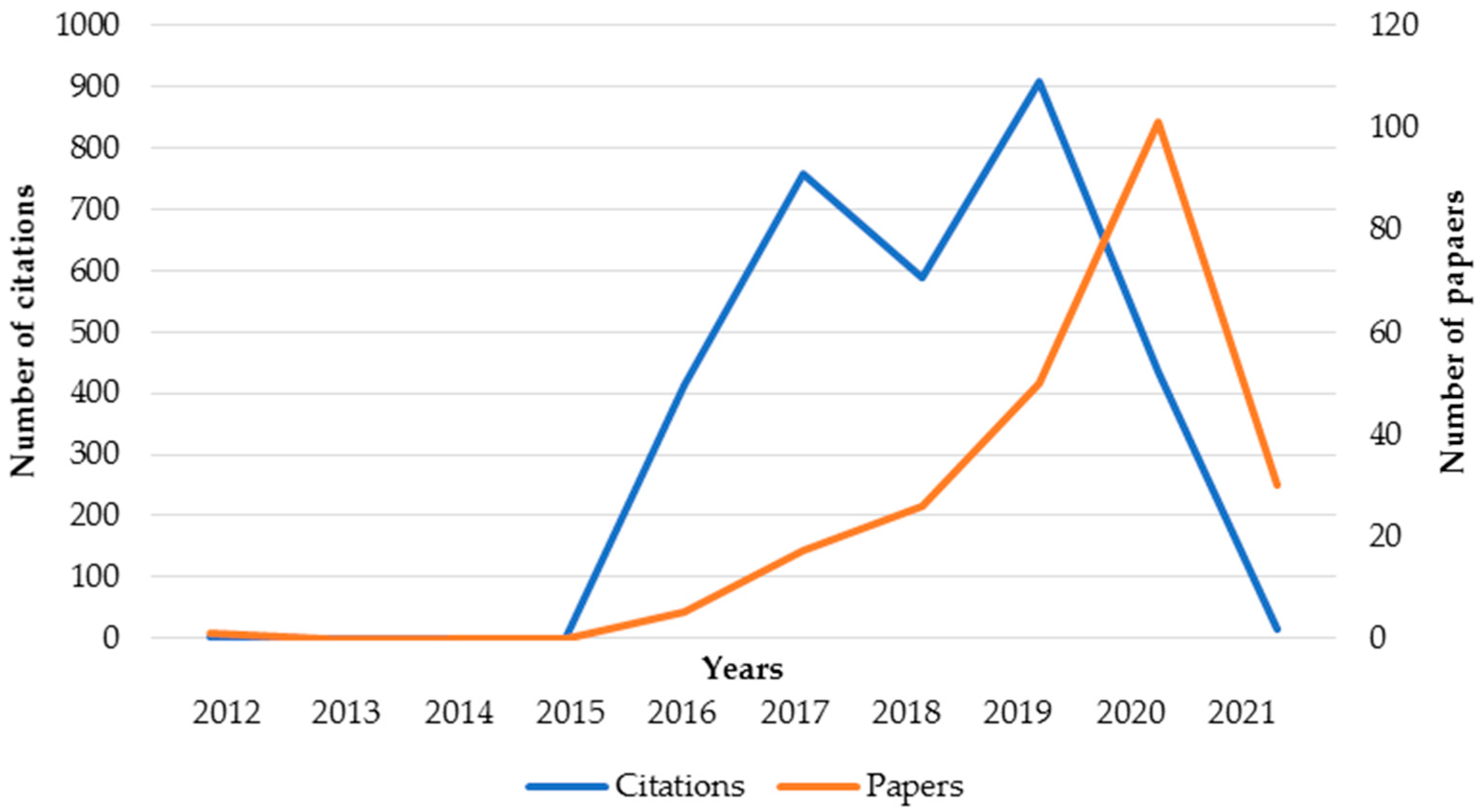
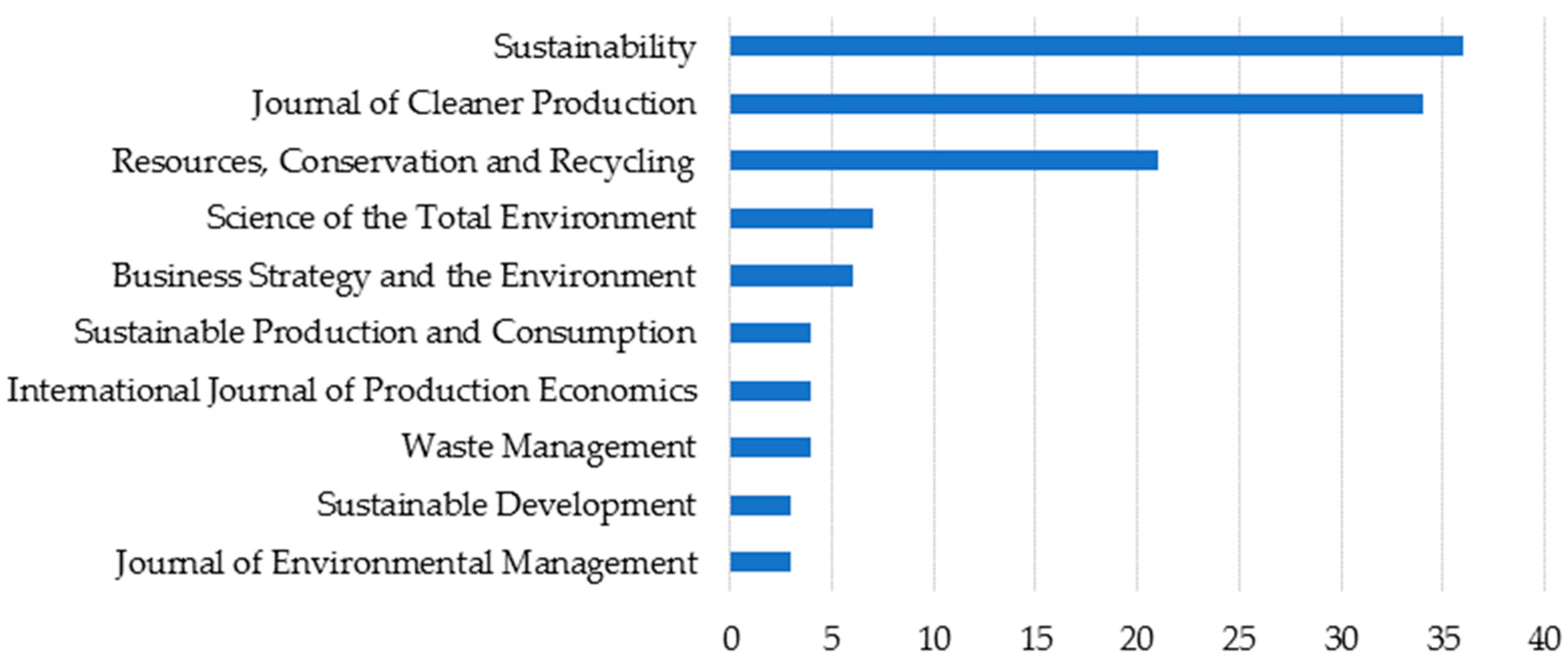
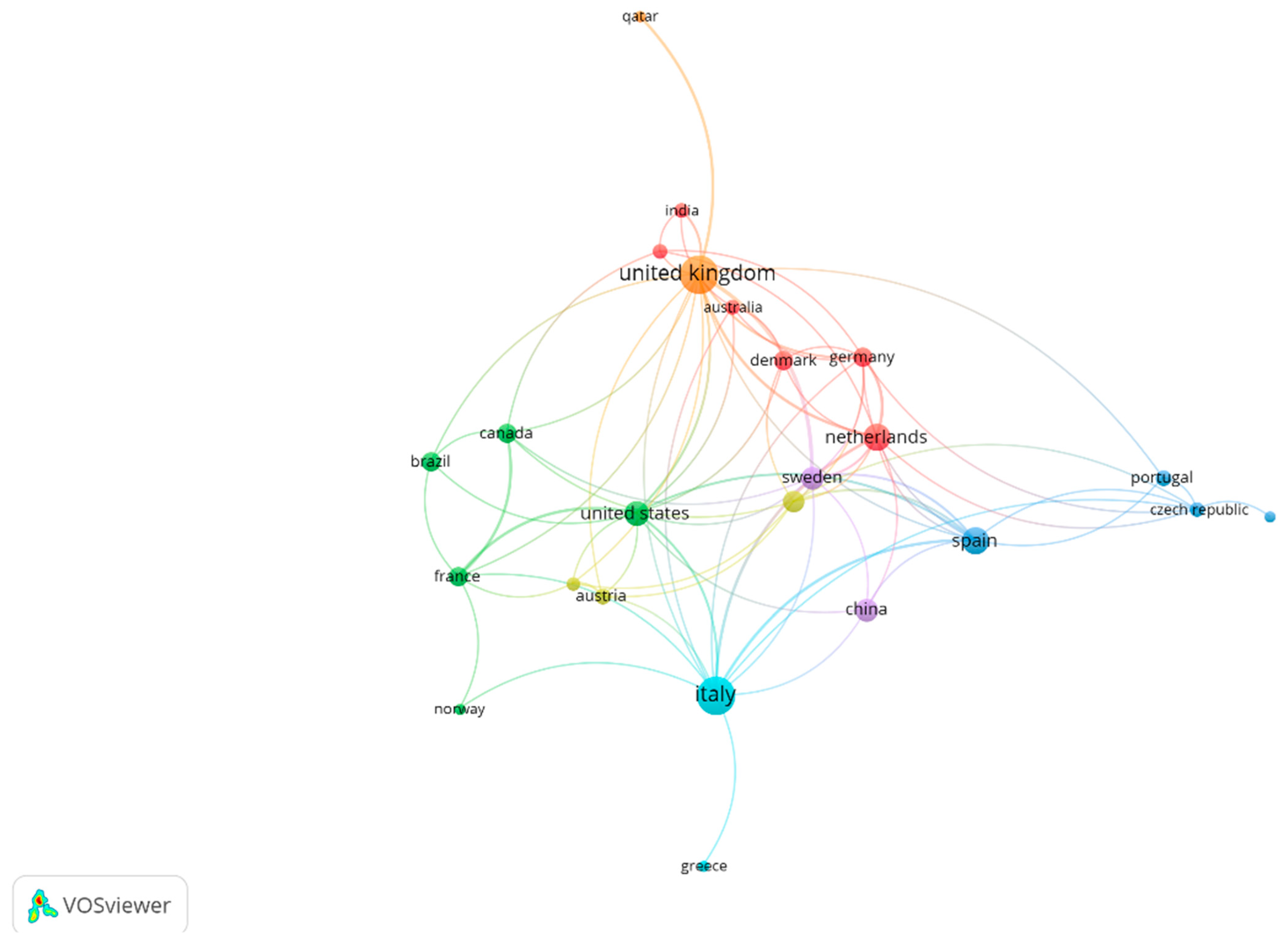
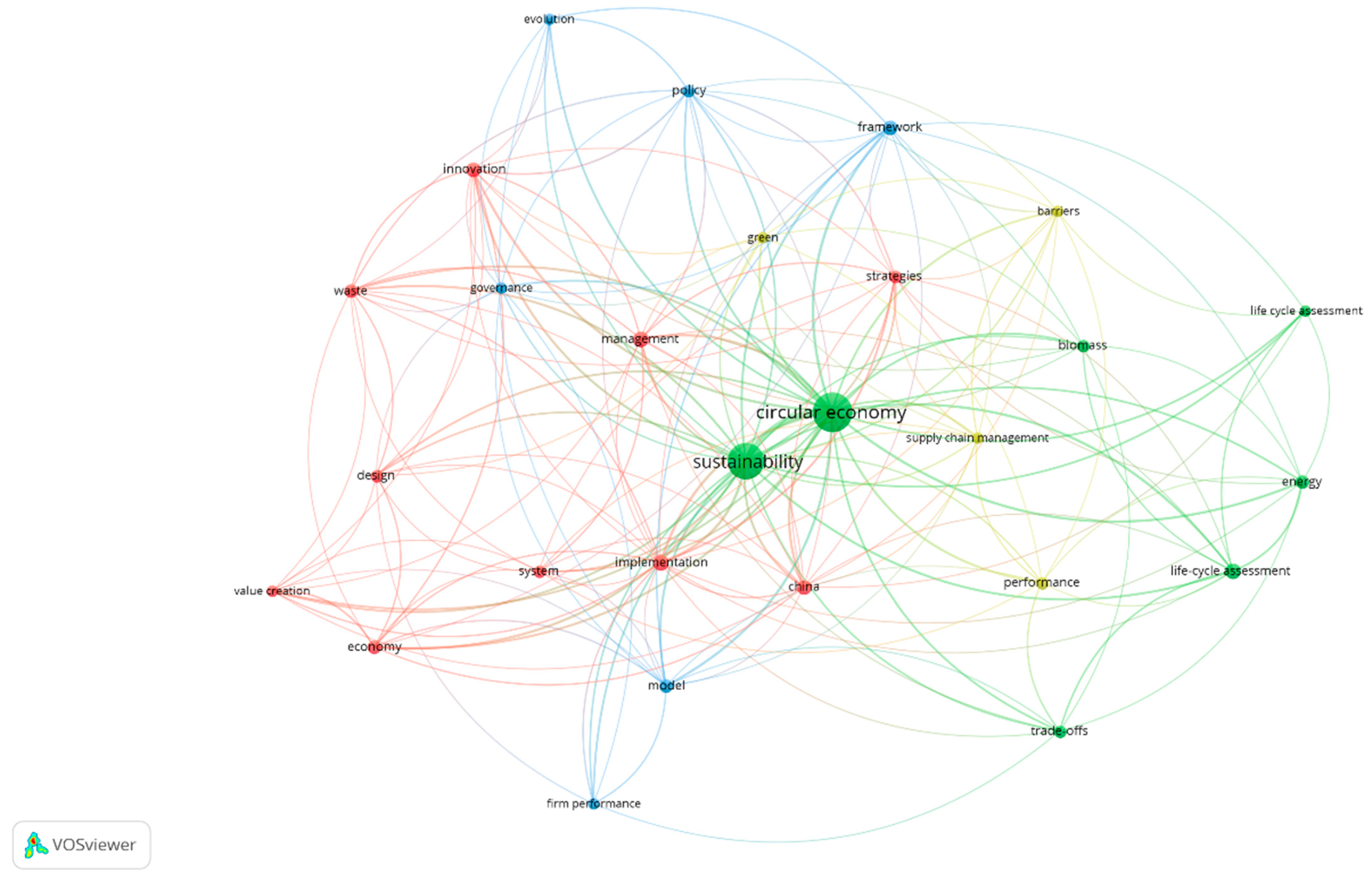
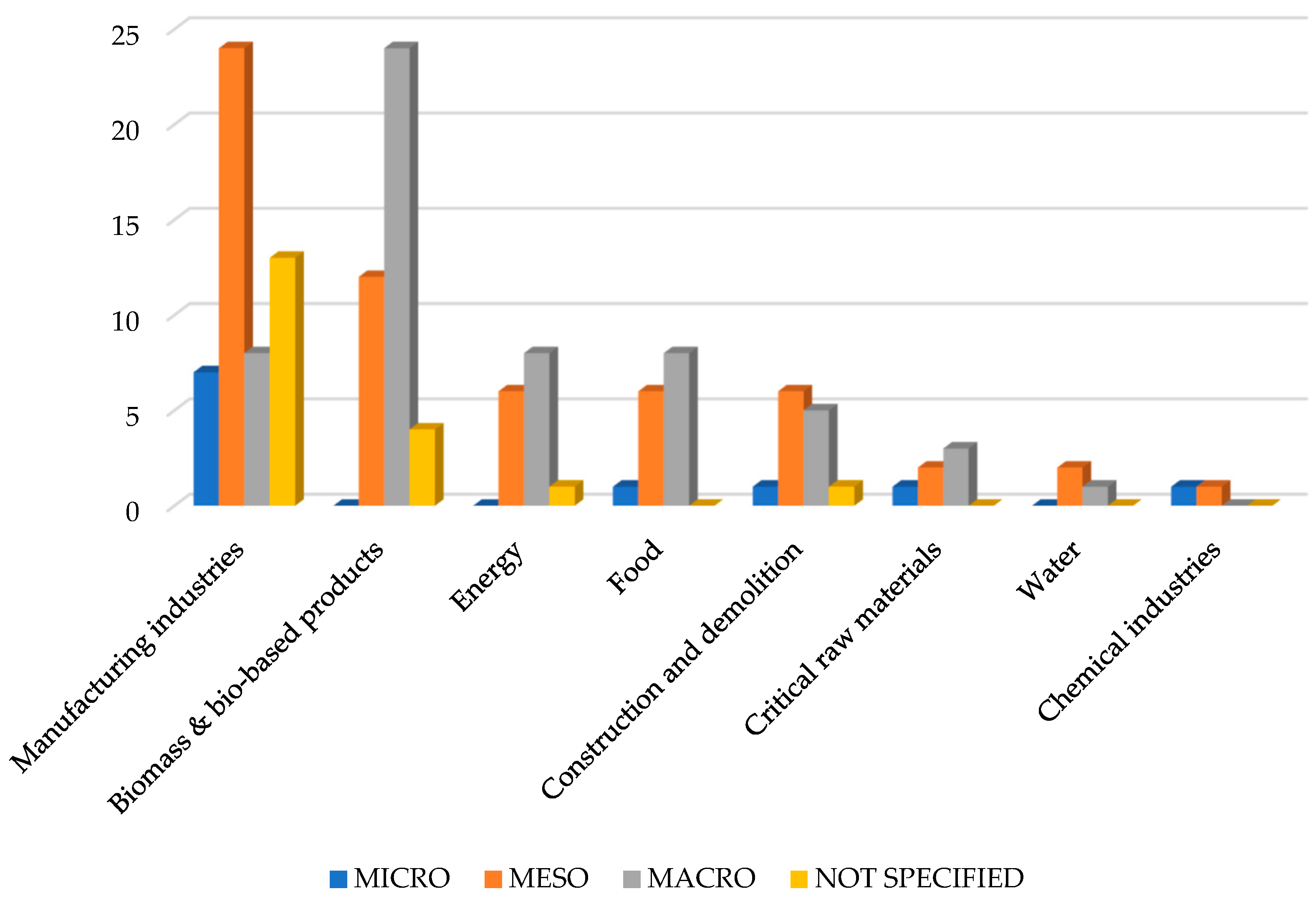
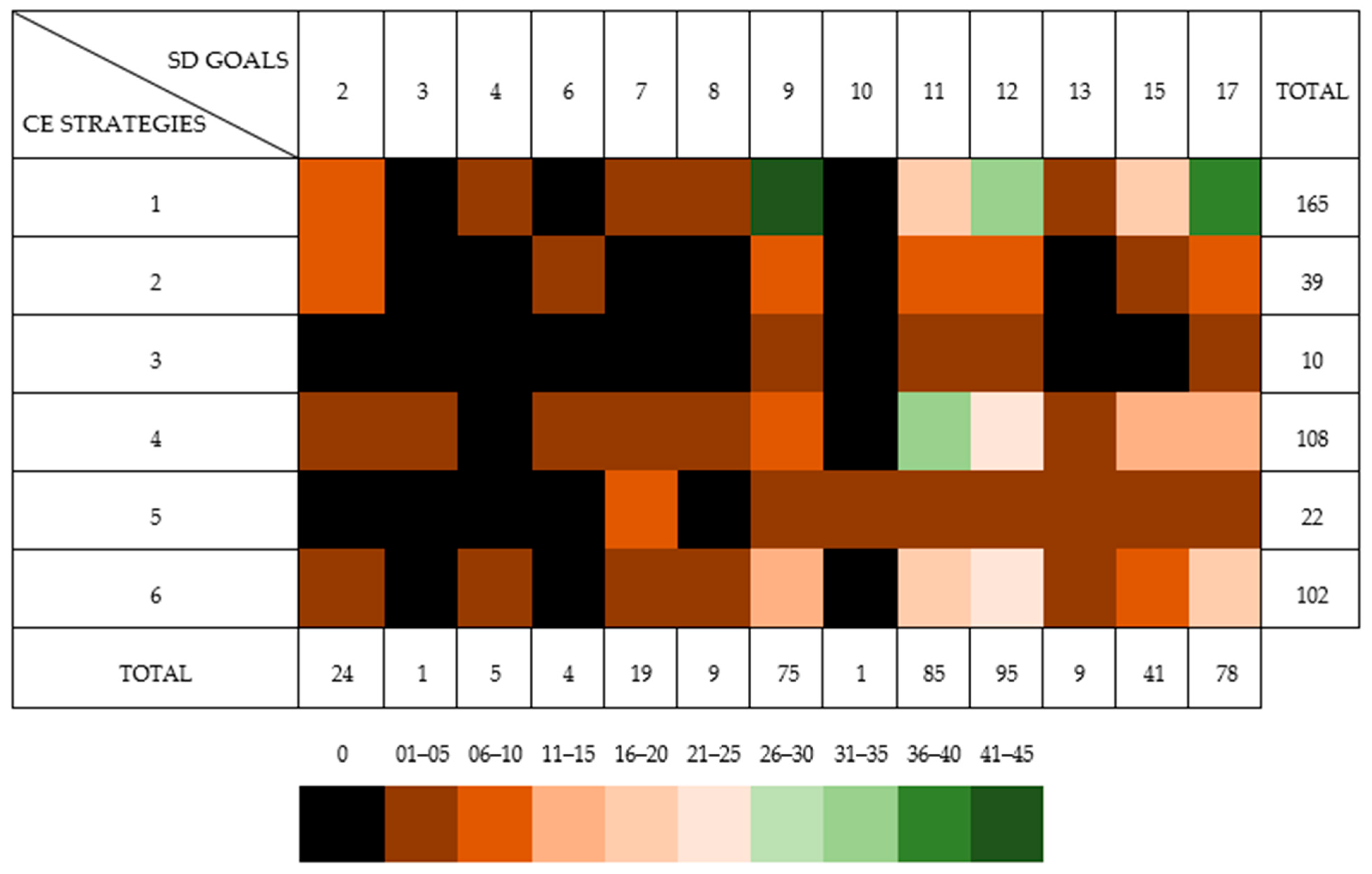
| Stages of the Process | Selection Criteria | Results |
|---|---|---|
| 1. Pre-analysis | Search and analysis of the term (“circular economy” AND “sustainability” AND (synergies OR trade-offs OR relationship OR interaction OR collaboration OR systemic) in Scopus® and Web of Sciences® databases on 25 April 2021. | Search: TITLE-ABS-KEY (“circular economy” AND “sustainability” AND (synergies OR trade-offs OR relationship OR interaction OR collaboration OR systemic) AND (LIMIT-TO (LANGUAGE, “English”) Scopus®: 478 articles Web of Sciences®: 482 articles TOTAL = 960 |
| 2. Duplicates removed | Verification of the duplicate articles and papers’ coincidence within both databases (Scopus® and Web of Sciences®). | When analyzing conformity of the literature review, 367 duplicate materials were removed from both collections using Covidence® software analysis in the CLR process. |
| 3. Data exploitation (Studies screened) | 3.1. Analysis of the title, keywords and the abstract in that order, to isolate the papers that were out of the scope of this systemic analysis because of pointed out meta-analysis or merely because they solely address technical issues, without looking at the relationship or influence between sustainability and CE, even if indirectly. | 593 documents screened, 337 articles were identified as irrelevant and excluded from the sample in the first screen round. |
| 3.2. Second round screening analysis, pointed out theoretical studies (bibliometric analysis, narratives, reviews, etc.), disregarding the potential synergies or trade-offs among sustainability and CE framework. | 256 full text-studies assessed for eligibility; 27 studies were excluded in the second round of the screen process. | |
| 4. Processing of the outcome | Assessment of the computational literature review type of analysis, Covidence® and adequate tools for scientific CAM and co-occurrence mapping through VOSViewer. | Indicators and bibliometric maps with VOSViewer from the final 229 articles collection. - Annual number of articles, - Scientific journals prevalence, - Countries productivity, - Co-occurrence of keywords, - Priority business sectors and its scale of analysis, - Matrix of interactions identified within SDGs and CE strategies in the literature. |
| Authors | Article Title | Year | Source Title | Total Citations |
|---|---|---|---|---|
| Genovese A.; Acquaye A.A.; Figueroa A.; Koh S.C.L. | Sustainable supply chain management and the transition towards a circular economy: Evidence and some applications. | 2017 | Omega (United Kingdom) | 321 |
| Witjes S.; Lozano R. | Towards a more Circular Economy: Proposing a framework linking sustainable public procurement and sustainable business models. | 2016 | Resources, Conservation and Recycling | 214 |
| Saidani M.; Yannou B.; Leroy Y.; Cluzel F.; Kendall A. | A taxonomy of circular economy indicators. | 2019 | Journal of Cleaner Production | 124 |
| Pieroni M.P.P.; McAloone T.C.; Pigosso D.C.A. | Business model innovation for circular economy and sustainability: A review of approaches. | 2019 | Journal of Cleaner Production | 123 |
| Nasir M.H.A.; Genovese A.; Acquaye A.A.; Koh S.C.L.; Yamoah F. | Comparing linear and circular supply chains: A case study from the construction industry. | 2017 | International Journal of Production Economics | 103 |
| Iacovidou E.; Velis C.A.; Purnell P.; Zwirner O.; Brown A.; Hahladakis J.; Millward-Hopkins J.; Williams P.T. | Metrics for optimizing the multi-dimensional value of resources recovered from waste in a circular economy: A critical review. | 2017 | Journal of Cleaner Production | 92 |
| Herczeg G.; Akkerman R.; Hauschild M.Z. | Supply chain collaboration in industrial symbiosis networks. | 2018 | Journal of Cleaner Production | 78 |
| Lazarevic; D; Valve; H | Narrating expectations for the circular economy: Towards a common and contested European transition. | 2017 | Energy Research and Social science | 73 |
| Sun, L; Li, H; Dong, L; Fang, K; Ren, JZ; Geng, Y; Fujii, M; Zhang, W; Zhang, N; Liu, Z | Eco-benefits assessment on urban industrial symbiosis based on material flows analysis and energy evaluation approach: A case of Liuzhou city, China. | 2017 | Resources, Conservation and Recycling | 71 |
| Supino S.; Malandrino O.; Testa M.; Sica D. | Sustainability in the EU cement industry: The Italian and German experiences. | 2016 | Journal of Cleaner Production | 66 |
Publisher’s Note: MDPI stays neutral with regard to jurisdictional claims in published maps and institutional affiliations. |
© 2021 by the authors. Licensee MDPI, Basel, Switzerland. This article is an open access article distributed under the terms and conditions of the Creative Commons Attribution (CC BY) license (https://creativecommons.org/licenses/by/4.0/).
Share and Cite
Morales, M.E.; Batlles-delaFuente, A.; Cortés-García, F.J.; Belmonte-Ureña, L.J. Theoretical Research on Circular Economy and Sustainability Trade-Offs and Synergies. Sustainability 2021, 13, 11636. https://doi.org/10.3390/su132111636
Morales ME, Batlles-delaFuente A, Cortés-García FJ, Belmonte-Ureña LJ. Theoretical Research on Circular Economy and Sustainability Trade-Offs and Synergies. Sustainability. 2021; 13(21):11636. https://doi.org/10.3390/su132111636
Chicago/Turabian StyleMorales, Manuel E., Ana Batlles-delaFuente, Francisco Joaquín Cortés-García, and Luis Jesús Belmonte-Ureña. 2021. "Theoretical Research on Circular Economy and Sustainability Trade-Offs and Synergies" Sustainability 13, no. 21: 11636. https://doi.org/10.3390/su132111636
APA StyleMorales, M. E., Batlles-delaFuente, A., Cortés-García, F. J., & Belmonte-Ureña, L. J. (2021). Theoretical Research on Circular Economy and Sustainability Trade-Offs and Synergies. Sustainability, 13(21), 11636. https://doi.org/10.3390/su132111636








